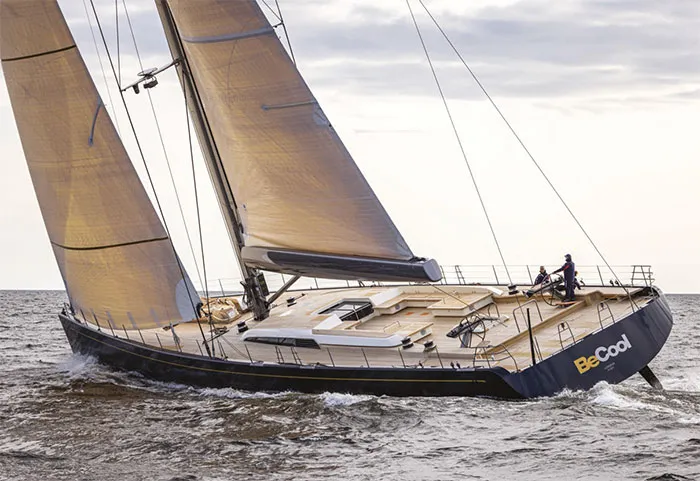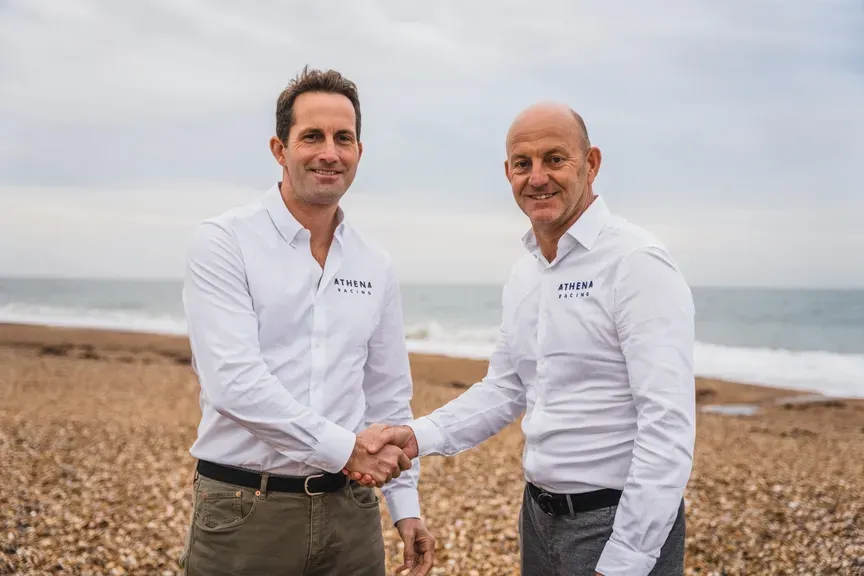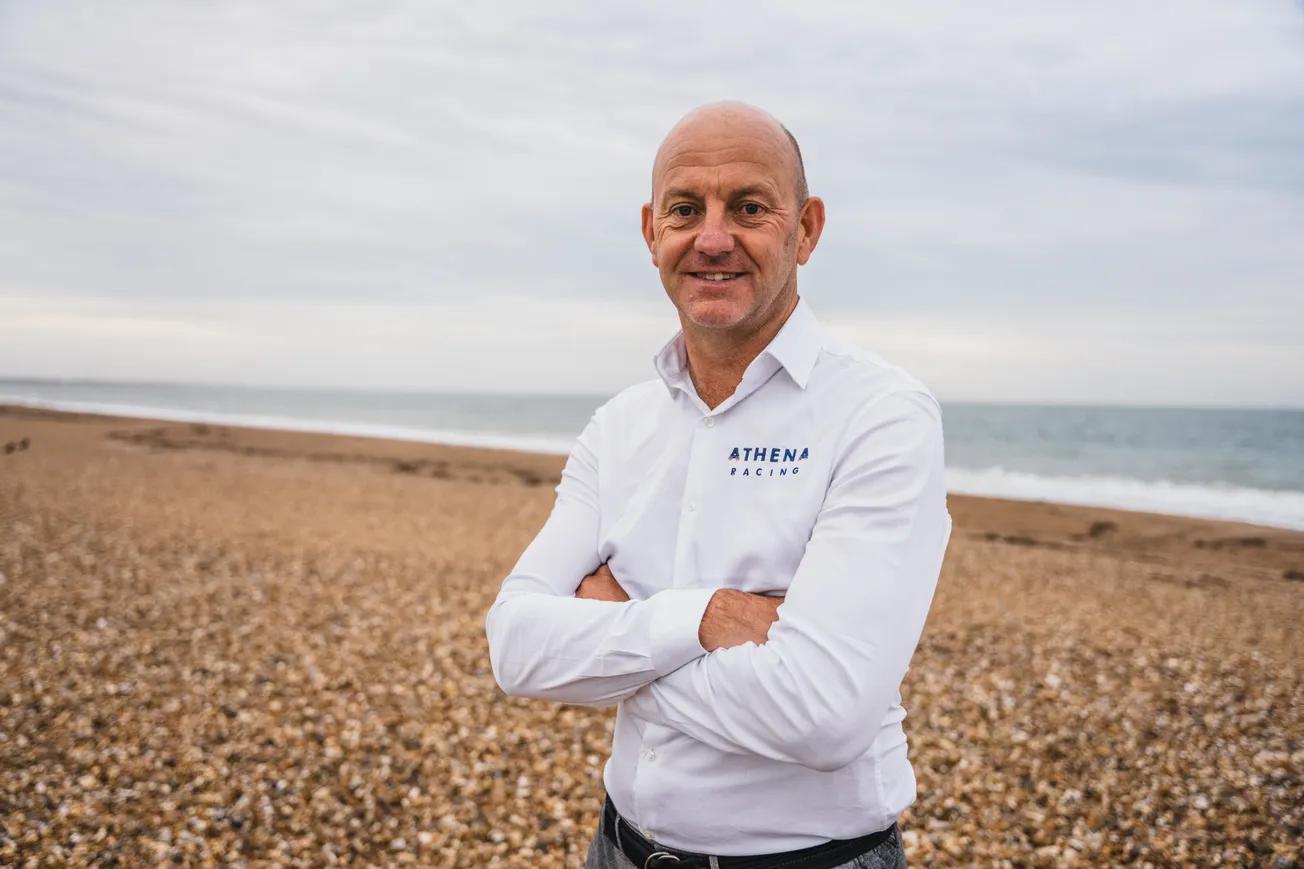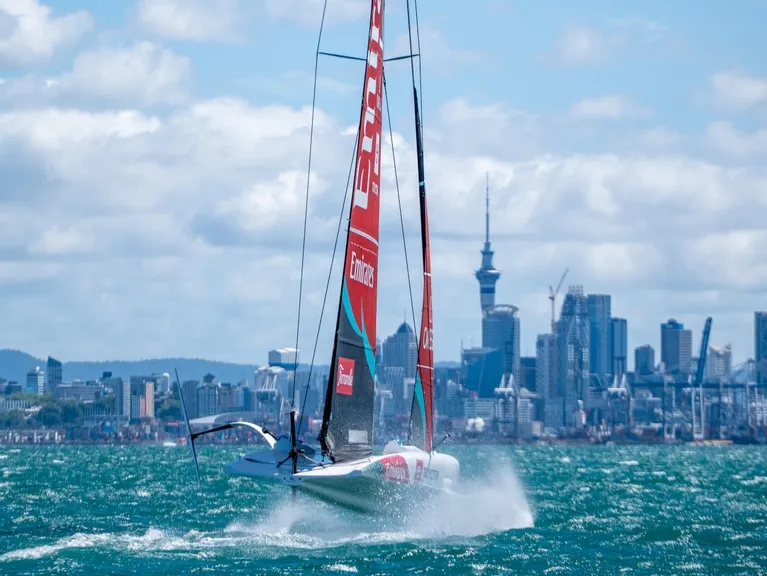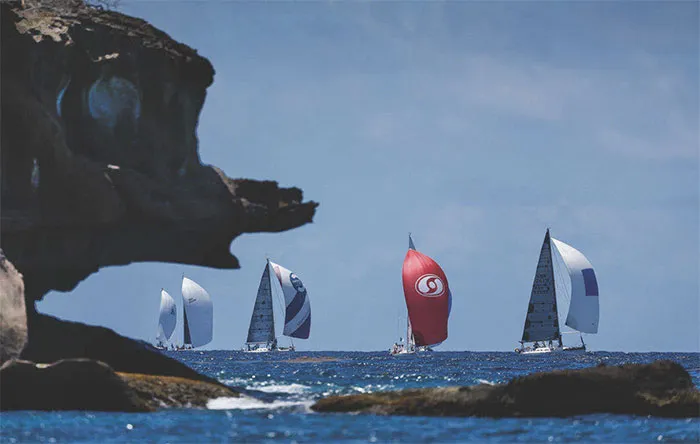


Very few collaborations in the yachting industry have been as enduring, productive or successful as the partnership between the Nautor shipyard and the naval architect Germán Frers. After almost half a century, with well over 40 models of Swan yachts put into production, it’s still going strong. Enter the latest in this long and iconic line of sailing yachts – and the second largest to date – the current flagship of the Maxi Swan range, the Swan 128.
The evolution of the Maxi Swan brand, which started gradually about eight years ago, has gathered pace since last year when Nautor merged with Sanlorenzo. It’s no mean feat to develop a range of yachts that appeals to both high-performance sailing enthusiasts and comfort-loving motor yacht owners. Credit is due, as this strategy seems to be working. Swan 128-01 was being prepared for delivery as this issue of Seahorse went to print and 128-02 was already in build.
‘We consider the new Swan 128 the ultimate expression of our evolution’, said Giovanni Pomati, chief executive of Nautor, at the official launch of the model. ‘She combines the purity of our design lines with comfortable interiors and a wide use of advanced technologies. We are truly proud and see this yacht as a benchmark in the world of maxi sailing.’
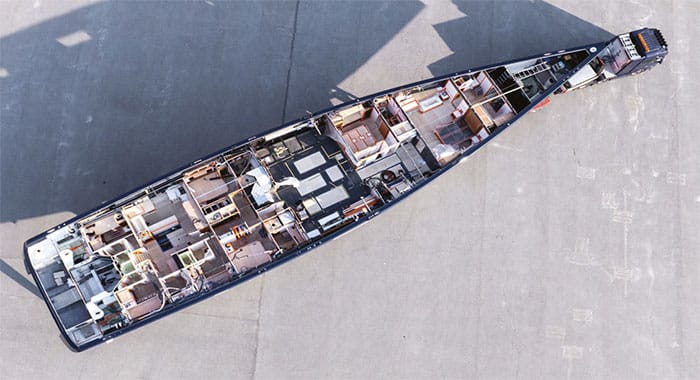
Any new Swan needs to sit comfortably within a well-defined set of parameters and the 128 is no exception. It has to look like a Swan and sail like a Swan, which might sound like a simple brief but is actually quite a complex challenge. The goalposts shift over time, not just with advances in technology and naval architecture but also to keep pace with changes in the lifestyles and tastes of the people who own these yachts and the ways they like to use them. Witness Swan 128-01, conceived as a replacement for both of her owner’s two previous boats: a performance-optimised Swan 98 and a 108ft (33m) fast planing tri-deck motor yacht.
Germán Frers’ clean and graceful hull lines are combined with Milanese design from the team that developed the strong, distinctive look of the current Maxi Swan fleet. Micheletti + Partners styled the deck and coachroof, Misa Poggi designed the interiors. Micheletti drew some of his inspiration from high-end automotive design and the clean, purposeful shape of the Swan 128 is a harmonious blend of Nautor brand legacy and contemporary aesthetics, building on the styling of the Swan 88 and 108. This new flagship of the range has an elegant but assertive presence on the water.
One thing to note is the absence of a bowsprit. Frers says this boat doesn’t need one, as there is already ample separation between the code sail luff and the headstay. ‘The main advantage of not having one is for the safety and comfort of the crew. They don’t really like having to go out on the end of a bowsprit. To keep them on deck is better.’ So is there no performance penalty? ‘Not within the parameters of this design,’ he explains. ‘And when she is racing the rating will take care of any small difference.’
Lucio Micheletti made his name as a sculptor before moving into architectural and yacht design and his signature feature on the deck of the Swan 128 is its streamlined, sculpted deckhouse topped with teak. This gives the yacht’s interior a semi-raised saloon with a large, forward-facing window while creating a sporty, dynamic exterior look.
The deck plan has two big halyard winches abaft the mast and a transverse track for the self-tacking jib or staysail. It follows the convention of three separate zones aft of the deckhouse: a large, open passenger cockpit with raised coamings and an optional retractable hardtop bimini that unfolds out of the coachroof chosen on 128-02; a working cockpit with two big winches on each side, forward of the helm pedestals; and a step down onto the stern deck which serves as a beach club area when the yacht is anchored. A large bathing platform folds out from the transom and there’s a garage between the twin rudder stocks for a 4.9m jet RIB tender.
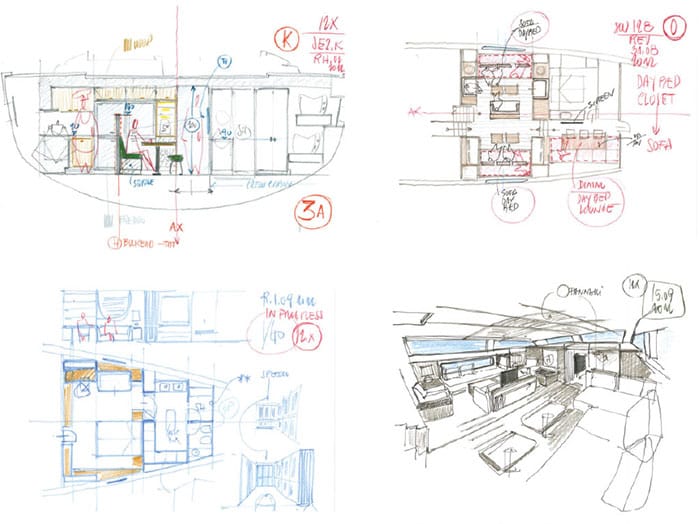
On the technical side, Frers’ design office invested in extensive CFD modelling, working with the respected consulting firm Cape Horn Engineering. A lot of emphasis was placed on maintaining a balanced hull shape through a range of heel angles, and also on refining the shapes of the lifting keel and rudders, to ensure good handling characteristics and helm response under sail. As with any semi-custom design, one of the primary goals was to create a versatile platform that allows ample scope for owners with a wide variety of sailing ambitions to optimise and customise their boats.
Key requirements in the design brief included high load carrying ability, ample interior volume, consistently good performance on most points of sail across a wide range of wind and sea conditions but especially in light winds, and a comfortable motion when going to windward in a seaway. This design also aims to achieve an optimal balance between easy handling for a small crew in cruising and delivery modes, and the potential to perform well in regattas with a full crew on board.
The result is a hull with a shallow canoe body, relatively moderate beam to length ratio, plumb bow with minimal forefoot, modest stern overhang and subtle positive sheer. The aft quarters flare above the waterline and start to confer a significant amount of form stability when the heel angle approaches 20°, which will provide some useful stiffness in stronger breezes without causing drag in light airs. At deck level, about 90 per cent of the boat’s maximum beam is carried all the way aft to the transom.
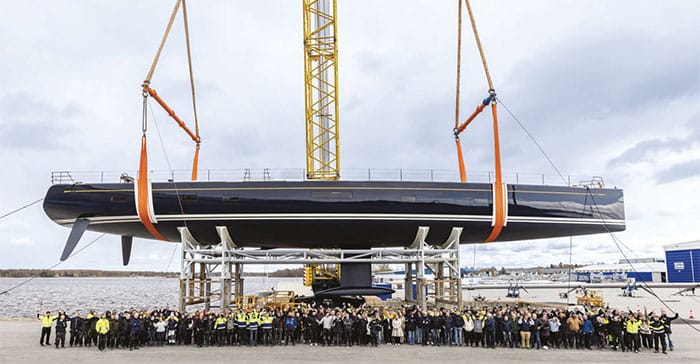
What’s the essence of a Swan? Germán Frers explains
‘Pekka Koskenkylä, the founder of Swan, approached me after the 1979 Fastnet Race,’ Germán Frers recalls, ‘when they decided that they wanted the design of their yachts to go in a different direction.’ The core range of Swans has always been multi-purpose yachts but it’s fair to say that the early models, designed first by Sparkman & Stephens – where Frers served his apprenticeship in the 1960s – and then by Ron Holland, were more keenly focused on offshore racing.
‘When I got involved, they asked me to do a Nautor version of [the Frers 50] Blizzard. That was during the 1979 Admiral’s Cup when I was sailing on Acadia, which was a sister ship of Blizzard. After the Fastnet disaster they decided to take a safer road with their designs.’ The result, launched in 1980 with a string of racing successes in its first season, was the now iconic Swan 51.
Swans had already earned an enviable reputation for being seaworthy, much of it earned by the S&S designs of the late 1960s and early 1970s. With Frers on board as Nautor’s go-to designer, a blueprint was established with balance, sea-kindliness, motion comfort and exceptional upwind performance as core sailing characteristics. This formula, refined and honed over many years, has served the brand extremely well ever since.
The fine sailing qualities of his yachts stem from Frers’ own wide-ranging, lifelong experience of sailing. Racing and cruising, coastal and offshore, he knows exactly what is required in a multi-purpose boat. ‘Sea kindliness is important,’ he says. ‘Boats should be able to power upwind, sometimes in a chop, and nobody likes pounding behaviour at sea. A word to define a good boat is harmony. Every aspect is important, you have to carefully manage everything to harmonise.’
An extra consideration comes into play for the Maxi Swans. ‘Most of the owners quite often have non-sailing friends on board and we have to understand that,’ he says.
Why has the Nautor-Frers partnership been so successful? ‘We manage to adapt to their requirements and their ways,’ he says. ‘There hasn't been any revolution, it’s been a continuous development over the years. I try to avoid fashion in design, in general. It’s a very good fleet and I think we’ve achieved a good compromise on almost every model.’
‘Looking to the future and how taste evolves, I base a lot of my findings on the design of cars. I’m careful not to design a boat that looks like a fast train with sails.
‘Probably the future will be selfstanding rigs with inflatable sails, I’ve been proposing that but it’s too early yet. Cruising boats may also be more like today’s racers, which are becoming quite different.’
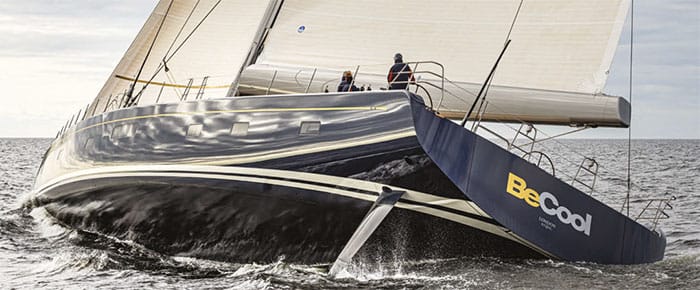
The general arrangement is a collaboration between Misa Poggi, Frers Studio and Nautor’s own in-house interior design office, with significant input from the owner’s team of 128-01. Two aspects to note are the large space in the foreship for the owner’s suite, with minimal intrusion of structural bulkheads, and a generous space aft for the crew who have a dedicated companionway leading down from the working cockpit.
Flexibility is a key characteristic of the Swan 128’s interior layout which is devised to give an owner, working either with Misa Poggi or their own choice of interior designer, as much creative freedom as possible. With eight skylights and six through-hull windows on each side, most if not all of the interior living spaces including the crew’s quarters will have good views out and plenty of natural light.
An extra-wide main companionway leads down from the passenger cockpit into the semi-raised saloon with large, sliding skylight hatches overhead. With windows on two levels, there’s a good view out whether you stand or sit. The standard configuration has a lounge on one side of the saloon and a dining area on the other, with a decent amount of separation between them, but the layout can be extensively customised. For example, day beds can be fitted alongside the throughhull windows to provide a comfortable place for guests to stretch out and relax indoors while the yacht is under sail.
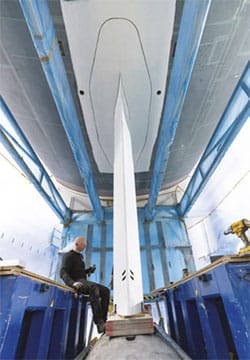
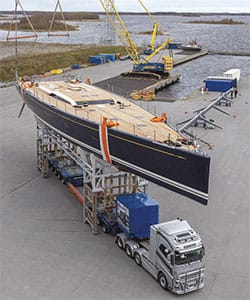
1. The first Swan 128 has a telescoping keel. A fixed keel is also an option. 2. Lucio Micheletti’s sculpted deckhouse adds a dynamic, sleek and sporty character to the Swan 128’s exterior.
Swan 128-01 has four double guest cabins with en suite heads, two forward of the saloon and two aft, plus three cabins and a mess room for up to six crew. A few steps down from the forward end of the main saloon there’s a TV lounge to starboard which converts into a dining room and a guest cabin with a double island bed to port. The master suite is in the bow with the bed facing aft, offset to starboard, a sofa and study desk to port and a full-beam bathroom up forward.
Aft of the main saloon, another flight of steps leads to the other two guest cabins. These are also large doubles but with beds against the hull sides, thus providing good sea berths for the yacht’s owner and guests if they remain on board for an offshore passage.
Two notable features of the crew’s quarters on Swan 128-01, which illustrate the convergence of sailing yacht and motor yacht design, are a large galley with a central island and a walk-in laundry with high-end appliances and an ironing station. Each of the crew cabins has its own private en suite heads with a separate shower compartment. The nav station is sensibly placed at the foot of the crew companionway.
The engine room occupies the whole space beneath the saloon, with doublefiltered access through a workshop area. The yacht’s main engine and generators, fuel and water tanks, batteries and other heavy machinery are thus clustered around the trunk of the lifting keel for optimal weight distribution.
One major difference between this latest generation of Swan superyachts and the previous one, as Germán Frers points out, is that hull construction has become much more sophisticated. All models in the current Swan Maxi range are full carbon composite builds, with Corecell and Gurit Sprint laminates. The hull and deck manufacturing process includes two-stage post-curing in a digitally controlled oven for about 20 hours, following a temperature curve up to 90°C, with a final post-cure for the structural assembly. Nautor’s build quality and standard of finish are of course core pillars of the shipyard’s reputation, along with the refined sailing characteristics that have always defined the Swan brand.


